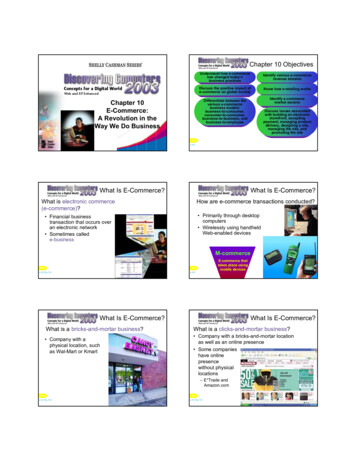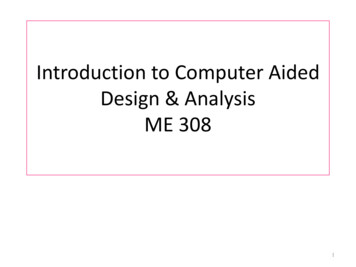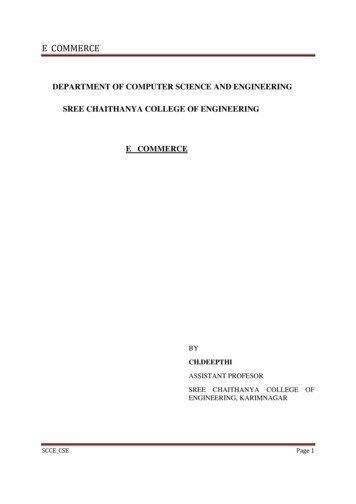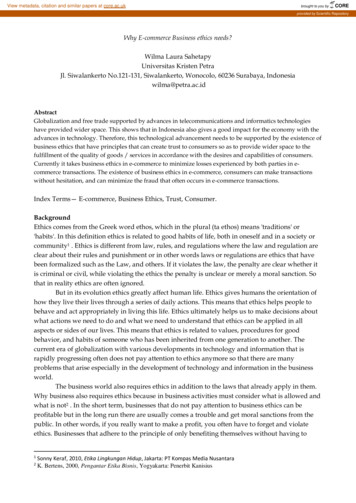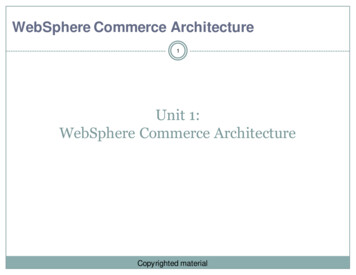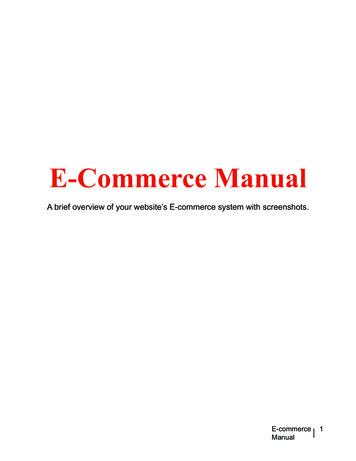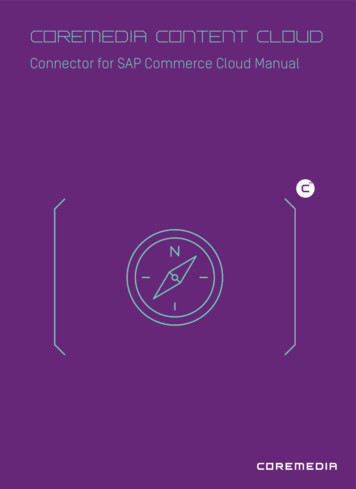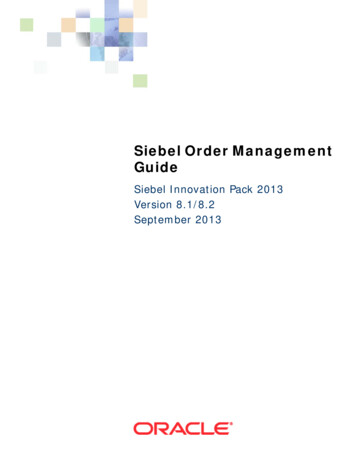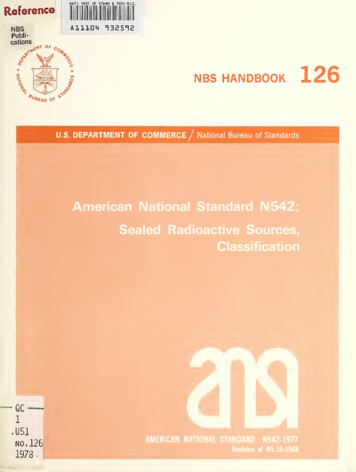
Transcription
NAT'L INST. OF STAND & TECH R.I.C.ReferenceNBSPubiiA111D4432S1SNBS HANDBOOKU.S. DEPARTMENT OF COMMERCE / National Bureau of StandardsAmerican National Standard N542;Sealed Radioactive Sources,Classification126
NATIONAL BUREAU OF STANDARDSThe National Bureau of Standards1 was established by an act of Congress March 3, 1901. TheBureau’s overall goal is to strengthen and advance the Nation’s science and technology andfacilitate their effective application for public benefit. To this end, the Bureau conductsresearch and provides: (1) a basis for the Nation’s physical measurement system, (2) scientificand technological services for industry and government, (3) a technical basis for equity intrade, and (4) technical services to promote public safety. The Bureau’s technical work isperformed by the National Measurement Laboratory, the National Engineering Laboratory,and the Institute for Computer Sciences and Technology.THE NATIONAL MEASUREMENT LABORATORY provides the national system ofphysical and chemical and materials measurement; coordinates the system with measurementsystems of other nations and furnishes essential services leading to accurate and uniformphysical and chemical measurement throughout the Nation’s scientific community, industry,and commerce; conducts materials research leading to improved methods of measurement,standards, and data on the properties of materials needed by industry, commerce, educationalinstitutions, and Government; provides advisory and research services to other GovernmentAgencies; develops, produces, and distributes Standard Reference Materials; and providescalibration services. The Laboratory consists of the following centers:Absolute Physical Quantities2 — Radiation Research — Thermodynamics andMolecular Science — Analytical Chemistry — Materials Science.THE NATIONAL ENGINEERING LABORATORY provides technology and technicalservices to users in the public and private sectors to address national needs and to solvenational problems in the public interest; conducts research in engineering and applied sciencein support of objectives in these efforts; builds and maintains competence in the necessarydisciplines required to carry out this research and technical service; develops engineering dataand measurement capabilities; provides engineering measurement traceability services;develops test methods and proposes engineering standards and code changes; develops andproposes new engineering practices; and develops and improves mechanisms to transferresults of its research to the utlimate user. The Laboratory consists of the following centers:Applied Mathematics — Electronics and Electrical Engineering2 — MechanicalEngineering and Process Technology2 — Building Technology — Fire Research —Consumer Product Technology — Field Methods.THE INSTITUTE FOR COMPUTER SCIENCES AND TECHNOLOGY conductsresearch and provides scientific and technical services to aid Federal Agencies in the selection,acquisition, application, and use of computer technology to improve effectiveness andeconomy in Government operations in accordance with Public Law 89-306 (40 U.S.C. 759),relevant Executive Orders, and other directives; carries out this mission by managing theFederal Information Processing Standards Program, developing Federal ADP standardsguidelines, and managing Federal participation in ADP voluntary standardization activities;provides scientific and technological advisory services and assistance to Federal Agencies; andprovides the technical foundation for computer-related policies of the Federal Government.The Institute consists of the following divisions:Systems and Software — Computer Systems Engineering — Information Technology.'Headquarters and Laboratories at Gaithersburg, Maryland, unless otherwise noted;mailing address Washington,D.C. 20234.!Some divisions within the center are located at Boulder, Colorado, 80303.The National Bureau of Standards was reorganized, effective April 9, 1978.
A-fl.TIU.NAL BUK.UAUOF STANDARDSLIBRA UYAUG I 8 1978-a-ct-Ceco-c 'fjo 1X0American National Standard N542;Sealed Radioactive Sources,Classification, ,nu a ti'T,A&, (2American National Standards InstituteSubcommittee N43-3.3Under the sponsorship of theNational Bureau of StandardsWashington, D.C. 20234Approved November 9, 1977American National Standards InstituteNew York, N.Y. 10018ANSI N542-1977(Revision of N5.10-1968)U.S. DEPARTMENT OF COMMERCE, Juanita M. Kreps, SecretaryDr. Sidney Harman, Under SecretaryJordan J. Baruch, Assistant Secretary for Science and Technology\j A NATIONAL BUREAU OF STANDARDS, Ernest Ambler, Director\ v\Issued July 1978
National Bureau of Standards Handbook 126Nat. Bur. Stand. (U.S.), Handb.126, 28 pages (July 1978)CODEN: NBSHAPU S. GOVERNMENT PRINTING OFFICEWASHINGTON: 1978For sale by the Superintendent of Documents, U.S. Government Printing Office, Washington, D.C. 20402(Order by SD Stock No. 003-003-01903-8.) Price 1.20.(Add 25 percent additional for other than U.S. mailing.)
American National StandardAn American National Standard implies a consensus of those substantially concernedwith its scope and provisions. An American National Standard is intended as a guide toaid the manufacturer, the consumer, and the general public. The existence of an Ameri can National Standard does not in any respect preclude anyone, whether he has approvedthe standard or not, from manufacturing, marketing, purchasing, or using products,processes, or procedures not conforming to the standard. American National Standardsare subject to periodic review and users are cautioned to obtain the latest editions. Pro ducers of goods made in conformity with an American National Standard are encouragedto state in their own advertising, promotion material, or on tags or labels, that the goodsare produced in conformity with particular American National Standards.CAUTION NOTICE. This American National Standard may be revised or withdrawn atany time. The procedures of the American National Standards Institute require that actionbe taken to reaffirm, revise, or withdraw this standard no later than five (5) years fromthe date of publication. Purchasers of American National Standards may receive currentinformation on all standards by calling or writing the American National Standards In stitute, 1430 Broadway, New York, New York 10018.iii
Preface(This Preface is not a part of American National Standard N542, Sealed RadioactiveSources, Classification.)Revised Standard—1977Work on this standard was begun in 1962 and culminated in publication in 1968 asANSI N5.10. When the original standard was in its final draft form a copy was sent tothe International Standards Organization (ISO). The ISO had been working on standardsfor sealed sources for several years. When the ANSI version was examined, the ISO de cided to adopt the ANSI concept and general format.ANSI procedures require that a standard be reviewed every five years. In 1973 whenANSI N5.10 was reviewed, it was decided to, essentially, duplicate the ISO version in itsfinal draft form which was published as ISO/DIS 2919 in November 1972. Although theANSI version contained sections on Quality Control and Leak Test Methods, the ISO ver sion deleted these sections and intends to cover these items in separate documents.This revised American National Standard is accompanied by sections in the appendixeson Quality Control and Leak Test Methods. The Quality Control section has been ex panded to provide a more definitive guide so that production run sources will have per formance characteristics equal to the fully tested prototype sources. The Leak TestMethods section has been up-dated to reflect current methods of leak testing.During the period when this standard was being revised, other groups developed stand ards for brachytherapy sources and self-luminous sources. An attempt was made to mergethese two standards, along with the IAEA tests for special form, into this classificationstandard. This attempt was not successful but, in order to make this standard more use ful, the standards for brachytherapy sources, self-luminous sources, and the special formtests are summarized in appendixes.IV
The American National Standards Committee, N43, on Equipment for Non-Medical RadiationApplications, which processed and approved this standard had the following personnel at the timeit approved this revised standard:Elmer H. Eisenhower, Chairman(National Bureau of Standards)Organization RepresentedAir Transport Association .American Chemical Society .American Conference of GovernmentalIndustrial Hygienists.American Crystallographic Association .American Federation of Labor and Congressof Industrial Organizations.American Insurance Association .American Iron and Steel Institute .American Mutual Insurance Alliance .American Nuclear Society .American Public Health Association, Inc.American Society of Mechanical Engineers .American Society for Nondestructive Testing, Inc. . .American Society for Testing and Materials .American Welding Society .Conference of Radiation Control Program Directors .Health Physics Society .Institute of Electrical and Electronics Engineers, IncInstrument Society of America .International Association of Machinistsand Aerospace Workers.International Brotherhood of Electrical Workers . . . .National Bureau of Standards.National Council on Radiation Protectionand Measurements.National Electrical Manufacturers Association .Underwriters’ Laboratories, Inc.U.S. Nuclear Regulatory Commission .U.S. Department of the Air Force, Office ofthe Surgeon General.U.S. Department of the Army, Office ofthe Surgeon General.U.S. Department of Defense .Name of Representative.Warren J. Weldon.Edward E. BeauchampLTC Gordon M. Lodde. Stanley BlockJack R. Suarez.John G. Pack.Anthony LaMastraWayne T. Brooks (Alt.). Leon D. HorowitzThomas F. Bresnahan (Alt.).vacantW. E. Kreger (Alt.).Francis J. BradleyJesse Lieberman (Alt.). Herbert R. Isenburger.John P. BattemaWarren M. Holm (Alt.).Marvin M. TurkanisJack Bystrom (Alt.).Edward L. Criscuolo. Leonard SolonRichard Lane (Alt.).John H. WeilerRobert M. Ryan (Alt.). Thomas R. Kohler.H. L. Cook, Jr.J. George Eichhorn. Paul R. Shoop. Elmer H. EisenhowerCarl B. BraestrupE. Dale Trout (Alt.). M. L. Jackson. Larry S. Homa. Robert F. BarkerLTC William D. HowellLTC Owen H. Kittilstad (Alt.)LTC Edward W. BlackburnCol. John E. Ward (Alt.). Satrak Der BoghosianCharles P. Merhib (Alt.)Walter E. GundakerU.S. Department of Health, Education, andEdwin A. Miller (Alt.)Welfare, Public Health Service.Individual Member . .John R. Dukesv
Members of the original subcommittee which produced ANSI N5.10 were:Barrer, L.Beauchamp, E.(Chairman)Brown, R.Coleman, E.Cook, H. L.Dooley, H.Dukes, J.Edling, D.Ewing, R.Ferraro, E.Gerhart, J.Hendrickson, J.Hetherington, C.Horn, L.Howard, N.Karp, W.Krieger, H.Lonadier, F.Malson, H.Milau, J.Miller, W.Niemeyer, R.O’Neill, J.Santoro, M.Selander, C.Smith, D.Turkanis, M.Walz, R.Members of Subcommittee N43-3.3 who were active during development of this revised standard were:Amlauer, K.Arndt, R.Bell, J.Cook, H. L.(Chairman)Dooley, H.Dukes, J.Eisenhower, E.Ferraro, E.Gerhart, J.Hanson, L.Homa, L.Horowitz, L.Janzow, E.Kotler, J.LaMastra, A.Landfried, C.Lima, J.McLellan, J.Ridout, E.Seminoff, T.Sererance, W.Shupe, M.Sims, G.Smith, D.Thompson, D.Turkanis, M.Tyree, P.Walz, R.Weiler, J.vi
ification Designation24.General Considerations25.Procedure To Establish Classification and Performance Requirements46.Identification47. Testing Procedures for Table 14Table 1—Classification of Sealed Source Performance Tests7Table 2—Classification of Radionuclides According to Radiotoxicity8Table 3—Activity Level9Table 4—Sealed Source Performance Requirements for Typical Usage9Appendix A:Leak Test Methods10Appendix B:Quality Assurance and Control13Appendix C:Summary of American National Standard N44.1-1973:Integrity and Test Specifications for Selected Brachytherapy Sources15Summary of ANSI N540: Classification of Self-LuminousLight Sources16IAEA Tests for Special Form Radioactive Material.Excerpts from IAEA Safety Series No. 6—Regulations forthe Safe Transport of Radioactive Materials, 1973Revised Edition19Appendix D:Appendix E:vii
American National StandardSealed Radioactive Sources, ClassificationThis standard establishes a system of classification of sealed radioactive sourcesbased on performance specifications related to radiation safety. It provides a manu facturer of sealed sources with a series of tests for evaluating the safety of hisproduct under specified conditions, and also assists a user of such sources to select atype which suits the intended application insofar as maintenance of source integrity isconcerned. Tests are prescribed for temperature, external pressure, impact, vibration,and puncture over a range of severity. Sealed source performance requirements areidentified for a variety of source applications, in terms of a specific degree of severityof each test. Appendixes are included on the subjects of leak test methods, qualityassurance and control, brachytherapy sources, self-luminous light sources, and specialform radioactive material.Key words: Classification; leak test; national standard; radiation safety; radiationsources; radioactive sources; radioactivity; sealed sources; standard.1.environment. Factors to be considered for ap plications in specially severe environments arelisted in 4.2 and 4.3.This standard makes no attempt to classifyeither the design of sources and their methodof construction or their calibration in terms ofthe radiation emitted.Several subjects relating to sealed sourcesand their testing are not treated, in detail, inthis standard. These are: selected brachyther apy sources; self-luminous light sources; IAEAtests for special form radioactive material. Ac cordingly, to make this document more com prehensive, these subjects are summarized inAppendixes C, D, and E.ScopeThis standard establishes a system of clas sification of sealed radioactive sources basedon performance specifications related to radi ation safety. It does not consider the radiationoutput of the sealed source.It provides a manufacturer of sealed radio active sources with a set of tests to evaluate thesafety of his products under specified condi tions, and also td assist a user of such sourcesto select types which suit the application hehas in mind especially where protection againstradioactivity is concerned. This standard mayalso be of guidance to regulatory authorities.The tests fall into several groups including,for example, exposure to abnormally high andlow temperature and a variety of mechanicaltests. Each test can be applied in several de grees of severity.2.DefinitionsThe definitions and terms contained in thisstandard, or in other American National Stand ards referred to in this document, are not in tended to embrace all legitimate meanings ofthe terms. They are applicable only to the sub ject treated in this standard.Although the standard classifies sealedsources by a variety of tests, it does not implythat the sealed source will maintain its integrityif used continuously at the rated classification.For example, a sealed source tested for onehour at 600 C may, or may not, maintain itsintegrity if used continuously at 600 C.capsule—protective envelope used for preven tion of leakage of the radioactive material.Table 4 of this standard includes a list, whichis not intended to be comprehensive, of typicalapplications of sealed radioactive sources witha suggested test schedule for each application.These schedules are minimum requirementscorresponding to the applications in the usualdevice—any piece of equipment designated toutilize a sealed source(s).dummy source—facsimile of a sealed source ofexactly the same material and construction as1
digits to indicate the year of approval of theAmerican National Standard used to determinethe classification followed by a letter and fivedigits.If the classification is based on performancetests prescribed in this standard (N542-1977),the two digits preceding the letter shall be 77.The letter shall be either a C or an E. A Cdesignates that the activity level of the sealedsource does not exceed the limit established inTable 3. An E designates that the activity levelof the sealed source exceeds the limit estab lished in Table 3.The first digit following the letter shall bethe Class number which describes the per formance for temperature.The second digit following the letter shall bethe Class number which describes the per formance for external pressure.The third digit following the letter shall bethe Class number which describes the per formance for impact.The fourth digit following the letter shall bethe Class number which describes the per formance for vibration.a sealed source but containing, in place of theradioactive material, a substance resembling itas closely as practicable in physical and chemi cal properties.model—descriptive term or number to identifya specific sealed source design.non-leachable—term used to convey that theradioactive material is virtually insoluble inwater and is not convertible into dispersibleproducts.prototype source—original of a model of asealed source which serves as a pattern for themanufacture of all sources identified by thesame model designation.prototype testing—performance testing of anew sealed source before sources of such de sign are put into actual use.radiotoxicity—the toxicity attributable to theradiation emitted by a radioactive substancewithin the body.The fifth digit following the letter shall bethe Class number which describes the per formance for puncture.sealed source—radioactive source sealed in acapsule or having a bonded cover, the capsuleor cover being strong enough to prevent con tact with and dispersion of the radioactive ma terial under the conditions of use and wear forwhich it was designed.Example: a typical industrial radiographysource designed for use unprotected would bedesignatedANSI 77C43515source holder—mechanicalsealed source.supportforthe4.The following two terms apply to industrialradiography, gamma gauges, and irradiatorsources:4.1 Explanation of Tables and Appendixes4.1.1. Classification of Sealed Source Per formance Tests (Table 1). This is a list of en vironmental test conditions to which a sealedsource may be subjected. The test classes arearranged in order of increasing severity withthe possible exception of Class X, which may beany special designated test.source in device—sealed source which remainsin the shielding during use.unprotected source—sealed source which, foruse, is removed or exposed from the shieldingby mechanical or other means.3.General ConsiderationsThe classification of each source type shallbe determined by actual testing of two proto type or dummy sources for each test in Table1, or by derivation from previous tests whichdemonstrate that the source would pass thetest if the test were performed.Classification DesignationThe classification of a sealed source shall bedesignated by the code ANSI followed by two2
4, the Class numbers specify the tests to whichthe sealed source shall be subjected, except thatfor the category ion generators, the completesource-device combination may be tested.Obviously, Table 4 does not cover all sourceusage situations. If the particular average en vironment differs from the values shown, or ifthe source usage is not shown, the specificationsof the source shall be considered on an indi vidual basis by the supplier, the user, and theregulatory authority. The numbers shown inTable 4 refer to the Class numbers used inTable 1.Compliance with the tests shall be deter mined by the ability of the sealed source tomaintain its integrity after each test is per formed. Methods of testing sources for in tegrity after testing are set out in Appendix A.A source with more than one encapsulationshall be deemed to have complied with a test ifit can be demonstrated that at least one encap sulation has maintained its integrity after thetest.4.1.2 Classification of Radionuclides Accord ing to Radiotoxicity (Table 2). This Table,taken from a current ICRP report, classifiesradionuclides into four groups according torelative radiotoxicity.If the radionuclide is not listed in Table 2,the source shall be considered on an individualbasis by the supplier, the user, the regulatoryauthority, or governmental advisory agency.4.1.5 Leak Test Methods (Appendix A). Ap pendix A lists currently acceptable leak test(integrity test) methods.4.1.6 Quality Assurance and Control (Appen dix B). To assure that production sources willhave performance characteristics equal to thetested prototypes used in classifying thesources, a good Quality Assurance and Controlprogram is necessary. Appendix B is includedas a guide to aid a manufacturer in establishinga specific program.4.1.3. Activity Level (Table 3). This Tableestablishes a maximum activity of sealedsources for each of the four radiotoxicitygroups in Table 2, without further evaluation.Sources containing more than the maximumactivity shall be subject to further evaluationof the specific usage and design. The activityshall be determined at the time of manufactureof the sealed source.Table 3 also defines the properties of theradioactive material within the sealed source as“leachable and/or reactive” and “non-leachableand nonreactive.” The physical and chemicalform and the geometrical shape of the radio active material used to determine these prop erties shall be the same as the physical, chemi cal and geometrical form of the radioactivematerial within the sealed source.4.1.7 Summary of ANSI N44.1—1973. Integ rity and Test Specifications for SelectedBrachytherapy Sources (Appendix C).4.1.8 Summary of ANSI N540—1975. Clas sification of Self-Luminous Light Sources (Ap pendix D).4.1.9 IAEA Tests for Special Form Radio active Material. Excerpts from IAEA SafetySeries No. 6—Regulations for the Safe Trans port of Radioactive Materials, 1973 RevisedEdition (Appendix E).4.2 Fire, Explosion or Corrosion. Table 4 doesnot consider exposure of the source-device tofire, explosion or corrosion. In the evaluation ofsealed sources and source-device combinations,the manufacturer and user must consider theprobability of fire, explosion and corrosion andthe possible results. Factors which should beconsidered in determining the need for actualtesting are:4.1.4 Sealed Source Performance Require ments for Typical Usage (Table 4). Table 4 isbased on current practice and typical environ ments in which a sealed source or source-devicewill be used. Average environment includesnormal and abnormal use (taking into accountreasonable accidental risks), but does not in clude exposure to fire or explosion. For sealedsources normally mounted in devices, consider ation was given to the additional protectionafforded the sealed source by the device whenthe Class number for a particular usage wasassigned. Thus, for all usages shown in Table(1) consequence of loss of activity;(2) quantity of active material contained inthe source;(3) radiotoxicity;3
(4) chemical and physical form and the geo metrical shape of the radioactive mate rial ;(5) environment in which it is used; and(6) protection afforded the source or sourcedevice combination.cific performance requirements (classificationnumbers).4.3 Radiotoxicity and Solubility. Except as re quired in Section 4.2 radiotoxicity of the radi onuclide shall be considered only when theactivity of the sealed source exceeds the valueshown in Table 3. If the activity exceeds thisvalue, the specifications of the source must beconsidered on an individual basis. If the activitydoes not exceed the values shown in Table 3,Table 4 may be used without further consider ation of either radiotoxicity or solubility.The designation according to section 3 shallbe marked on the sealed source or source con tainer or source holder or accompanying docu ment.6. Identification7. Testing Procedures for Table 17.1 General. The testing procedures given inthis section present acceptable procedures fordetermining performance classification num bers. All the test environments provide theminimum requirements. Procedures which canbe demonstrated to be at least equivalent arealso acceptable. All tests, except the temper ature tests, shall be carried out at ambient tem perature.5. Procedure To Establish Classificationand Performance Requirements5.1. Establish radiotoxicity group from Table 2.5.2 Determine amount of activity allowablefrom Table 3.7.2 Temperature Test15.3 If the desired quantity does not exceed theallowable quantity of Table 3, an evaluation offire, explosion, and corrosion probabilities shallbe made. If no significant probability with re spect to fire, explosion, and corrosion exists, therequired classification for the source (per formance requirements) may be taken directlyfrom Table 4. If a significant probability doesexist, the factors listed in 4.2 shall be evaluatedwith particular attention to the temperatureand impact requirements.7.2.1 Equipment. The heating or coolingequipment shall have a test zone volume of atleast five times the volume of the test specimen.If a gas or oil-fired furnace is used for the tem perature test, an oxidizing atmosphere shall bemaintained throughout the test.7.2.2 Procedure. All tests shall be performedin air except in the low temperature test, whenan atmosphere of carbon dioxide is permitted.All test sources shall be held at the maximum(or minimum, for low temperature tests) testtemperature for a period of at least 1 h.Although Table 1 specifies a low temperatureof -40 C, “dry ice” may be used as the coolingmaterial. Thus, the low temperature may ap proach —75 C.Sources to be subjected to temperatures be low ambient shall be cooled to the test temper ature in less than 45 minutes.Sources to be subjected to temperature aboveambient shall be heated to the test temperatureat least as rapidly as indicated by the follow ing time-temperature table.5.4 If the desired quantity exceeds the allow able quantity of Table 3, an evaluation of fire,explosion or corrosion probability and a sep arate evaluation of the specific source usageand source design shall be made.5.5 After the required classification of thesource for the particular application or usagehas been established, the performance test con ditions can be obtained directly from Table 1.5.6 Alternatively, the source may be tested, thesource Class determined from Table 1, and somesuitable application selected from Table 4.Sources of an established classification may beused in any application having less severe spe 1 Part of this test for Class 6 is similar in principleto the heating test given in IAEA regulations for thesafe transport of radioactive materials.4
TimeTemperaturemin C05103060120ambient10022045075010107.4 Impact Test27.4.1 EquipmentThis comprises:(1) A free falling steel hammer which hasa flat striking surface, 25 mm in diameter withthe edge rounded to a radius of 3 mm. The cen ter of gravity of the hammer lies on the axis ofthe circle which defines the striking surface.(2) A steel anvil, the mass of which is atleast ten times that of the hammer. It is rigidlymounted so that it does not deflect during im pact. It has a flat surface, large enough to takethe whole of the source.(3) For the Class 2 drop test, the steelplate shall be rigidly mounted so that it will notdeflect appreciably during the test.For Classes 4, 5 and 6, test sources shall alsobe subjected to a thermal shock test. Either asecond test source or the source used in thetemperature test may be used. If the latter isused, it shall be evaluated for passage of thetemperature test before it is subjected to thethermal shock test.For the thermal shock test, the source shallbe heated to the maximum test temperature(required for that particular Class) and heldat that temperature for at least 15 minutes.The test source shall be transferred, in 15 sec onds or less, to water at a maximum temper ature of 20 C. The water shall be flowing at arate of at least ten times the source volume perminute, or, if the water is stationary, it shallhave a volume of at least twenty times thesource volume.7.4.2 Procedure. Choose the mass of the ham mer according to the mass specified in Table 1.Adjust the drop height to 1 m measured be tween the top of the source positioned on theanvil and the base of the hammer in the releaseposition.Position the source so that it offers its mostvulnerable area to the hammer.Drop the hammer onto the source.7.2.3 Evaluation. Test sources shall be ex amined visually and subjected to an appro priate integrity test such as that described inAppendix A.7.4.3 Drop Test. For the Class 2 drop test,the test sources shall be dropped so that allsurfaces are impacted at least once.7.4.4 Evaluation. Test sources shall be ex amined visually and subjected to an appropriateintegrity test such as that described in Appen dix A.7.3 External Pressure Test7.3.1 Equipment. The pressure gauge shallhave been recently calibrated and should havea pressure range of at least 10% greater thanthe test pressure. The vacuum gauge must readto a pressure at least as low as 20 kN/m2 ab solute. Different test chambers may be used forthe low and high pressure tests.7.5 Vibration Test7.5.1 Equipment. A vibrating machine cap able of producing the specified test conditions.7.5.2 Procedure. Fix the source securely tothe platform of the vibrating machine so thatat all times the source will be rigidly in contactwith the platform.7.3.2 Procedure. Place the test source in thechamber and expose it to the test pressure fortwo periods of 5 minutes each. Return the pres sure to atmospheric between each period. Con duct the low pressure test in air. For the highpressure test only water shall be used.For Classes 2 and 3, subject the source to thethree complete test cycles for each condi
American National Standard N542; Sealed Radioactive Sources, Classification , , _nu a ti'T, A&, (2 American National Standards Institute Subcommittee N43-3.3 . Under the sponsorship of the National Bureau of Standards Washington, D.C. 20234 . Approved November 9, 1977 American National Standards Institute New York, N.Y. 10018 . ANSI N542-1977

